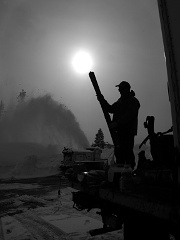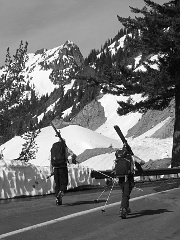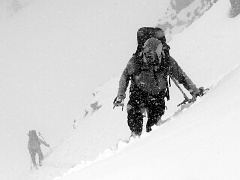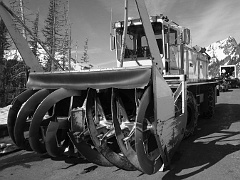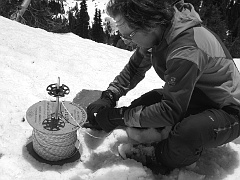|
|
|||||||||||||||
 |
||||||||||||||||
 |
||||||||||||||||
|
||||||||||||||||
|
We are, in the words of Monty Atwater, “avalanche hunters.” Each day finds us searching for avalanche conditions, anticipating the key moment when instability will be at its greatest. Mountaineers, skiers and avalanche forecasters all understand the importance of timing. For the backcountry traveler, being in the right place at the right time means good weather, route conditions, and stable snow, the recipe for a successful trip. Recreationists will often change destinations at the last minute to find favorable conditions.
The avalanche controller, on the other hand, is devoted to a single place for a designated time, be it a week, a month, or an entire season. They get to know the area inside and out, see the changes that occur with the passing of storms and the progression of the seasons. The snowpack evolves and is in turn affected by the actions of the controller. We search for the time when bombs and skis will provide the greatest return. Large avalanches are here for the taking and we live for the days when the taking is good. At Chinook Pass last spring we encountered an avalanche cycle that our team will long remember. The snowpack was like a late pregnancy, nothing could stop the inevitable. Wind and low clouds often dampen the action, but not during this week. Regardless of daily weather variation, the slopes let loose day after day. The ease with which avalanches started was remarkable. Snowballs thrown onto slopes released Class 3 avalanches that easily ran to the valley floor. Ski cuts and explosives only added to the volume of snow. Individual paths ran several times, and slopes that had seen the action of skis or explosives were ripe and ready to slide a few days later. Natural avalanches were happening with regularity up and down our little stretch of highway. The excitement was overwhelming, yet we needed to exercise utmost caution. Wet slab avalanches lurked within the snowpack. We had to keep our guard up at all times. By the end of the week, the results of natural and human-triggered avalanches made the valley look like a war zone. Over two miles of previously cleared highway was once again buried. We hoped that the equipment operators were as impressed as we were.
Nimble skis, thundering snows Spring avalanche control at Chinook Pass is unique among the highways of the Pacific Northwest and perhaps North America. Each year, in early April, the Washington State Department of Transportation (WSDOT) dispatches a group of avalanche forecasters to prepare the pass for opening in late May. No artillery is used to fire at the slopes nor are chairlifts employed to carry workers and their supplies. Instead the workers climb the ridges using backcountry skiing equipment. They often carry heavy packs filled with explosives and endure harsh weather. My partner Aaron Opp and I are members of this unique program, which employs four avalanche forecasters and an equal number of equipment operators. Chinook Pass (5432ft) is located in the south-central Cascade Mountains of Washington. The location has both ample snowfall and steep terrain, perfect ingredients for avalanches. The pass is closed each winter due to heavy snowfall and widespread avalanche hazard. State Highway 410 over the pass is not a major commerce route across the state. Instead, it is primarily a recreational highway, a two-lane serpentine route that offers passage to those seeking an escape to the mountains. When most of the winter snow season has passed, WSDOT moves avalanche forecasters from Snoqualmie Pass and maintenance crews from Naches to Chinook Pass to remove the accumulated snow and reduce the avalanche hazard. Here we find a snowpack that has been virtually undisturbed by humans during the winter.
Our program is unique not only because of our extensive use of backcountry skiing techniques, but also because our goals and constraints are different from both traditional highway forecasting and ski area avalanche control. The ski patroller looks to make slopes safe for the customer to enjoy—the avalanche hazard needs to be reduced and the snow needs to be enjoyable. The traditional highway forecaster needs to strike when the instability is rising and traffic volumes are declining—the hazard needs to be eliminated and the delay to commerce must be minimal. Chinook Pass avalanche control shares the common goal of hazard reduction, but downtime is less of a concern for us, since the highway has been closed all winter. The goal of eliminating the hazard is paramount. We want to reduce as much of the hazard as we can—and do it permanently. Our strategy is to eliminate the snowpack from the avalanche starting zones. Time is ultimately on our side, yet when the action is at its hottest we want to be everywhere at once. Large amounts of explosives may be used one day and simple ski cutting may be the best method the next. You never really know what the snowpack has in store until you get out there. Forecasting is, as always, the biggest challenge.
The Chinook Pass operation requires coordination between avalanche forecasters on skis working high on the mountain slopes and heavy equipment crews who clean up the skiers’ handiwork down at the highway. While the forecasters employ skis and backpacks powered by legs and lungs, the equipment operators wield bulldozers, snow blowers, and front-end loaders. These massive hunks of steel run on diesel and move tons of snow by the hour. They have miles of road to clear, and day after day the machines make slow and steady progress toward Chinook Pass. Yet, powerful as they are, the machines are no match for the power of nature when it has been unleashed by a ski-bound avalanche forecaster. When conditions are right, a day of setting explosives or ski-cutting near the ridge can erase a week of hard work by the heavy equipment below. The evolution of the snowpack is one of the pleasures of working at Chinook Pass. When we arrive in April, spring has taken hold in eastern valleys, but winter still grips the higher slopes. We may get five to seven feet of snowfall throughout the spring and that usually happens during the first few weeks. By May, change is under way. We see it first in the easternmost portions of our work area and on the lower slopes. Spring advances up the slopes from east to west and from valley to ridge. Slowly the instability is removed. The snowpack which started out fine-grained and layered becomes firm, homogeneous and well drained. Avalanches are nearly impossible to trigger. Holes open, creeks burble underfoot. South exposures open quickly, rocks grab for your skis. If we have been on our game, we will have triggered enough avalanches, or sizeable enough avalanches, to dig deep troughs in the main paths. These troughs scour down into the snowpack until rocks and brush are exposed. The sun heats the rocks, brush, and earth, adding to the melt. Bare tracks are impedance to avalanches. Our highway travelers are safe from avalanches and free from the delay of the avalanche hunters. The remaining snow is sun-cupped, our skis are sticky with pollen, and our faces are a deep tan. Summer is here, even if the calendar tells us to wait a few more weeks.
A day to remember As beautiful as the mountains around Chinook Pass are, the task of removing so many tons of snow becomes routine, even monotonous. Wise backcountry skiers learn to beware of complacency bred by familiarity with the terrain. The same is true of avalanche forecasters. For our crew the issue is compounded. We have our own safety to consider—when and where to travel—and we have the safety of the equipment operators to consider as well. They rely on us completely. We must wait until the conditions are best for producing avalanches, yet not wait too long. Occasionally the elements combine to create a perfect moment. One particular day a few years ago remains unique in my experience. On this particular day we arrived to find the snowpack well ahead of our schedule. Instability rose early and we needed to get our butts in gear. A quick decision was made to bring two equipment operators and two forecasters to the summit parking area. The truck delivering the operators barely made it back down the road before avalanches blocked the highway. We knew we were going to obliterate the road that day. Avalanche weather was here. A small problem remained—we would not be able to go back down the road to the east at the end of the day due to the amount of snow that would be covering the previously cleared highway. The connection to the west side had not been established yet. Our equipment operators said they could do it, as long as they did not encounter any equipment problems. “Leave it to us, we’ll get it done,” and off they went.
My longtime co-worker Rob Gibson and I took off in pursuit of the avalanches, following the same route that we have followed a hundred times. After applying climbing skins, we turned the heels of our ski touring bindings and settled into the rhythm of the ascent. Our packs bulged with explosives for the work ahead. We reached the ridge and began setting up our first shot. After the boom, we set out on skis for a fun round of ski cutting. Everything we laid our skis across broke free and began entraining massive amounts of snow. These avalanches buried the highway and continued to the valley floor 1000-1500 feet below us. It was an awesome sight. On our second trip to the ridge, we could feel the intensity of the sun and the increasing humidity. The air was sticky and the snow was wet. Snowballs started large avalanches. We were the proverbial kids in a candy store. By the time we reached the top again, clouds were moving in. Thunderstorms could be heard to the southeast. Quickly, we set up our final shot of the day, never pausing a moment. The shot took another large avalanche to the valley floor. We raced to peel the skins off our skis, reload our packs, and squeeze in a quick sip of water. A ridge is no place to be when lightning is coming. The ski cutting was still prime, as good as it ever gets. The snow peeled away, gathering mass and speed quickly. When the slides hit the road, they sounded like enormous waves crashing into a seawall. These conditions are, in and of themselves, impressive, but the sky was now beginning to steal the show. Dark clouds created a bizarre light and color shift to the environment. Lightning began to flash across the clouds and one of the most surreal moments unfolded before us. Avalanches were crashing through trees and rocks onto the highway, amid the crack and boom of the lightning and thunder, and that odd and spooky light. We live for these moments. When we reached the vehicles, our trusty plow drivers were waiting. The connection was completed and we had a route home. No sooner were we out of our ski boots and into the cab of the truck then the rain started. Away we went down to Cayuse Pass and onward to White Pass, triumphantly driving through the rain as smiles formed creases in the dried sweat and sunscreen on our deeply tanned faces. Our eyes twinkled with a hint of mischief—it had been a great day. |
|
|
||||||||||||||||||||||||||||||||||||||||||||||||||||||||||||||||
| ©2010 Northwest Mountaineering Journal | ||||||||||||||||||||||||||||||||||||||||||||||||||||||||||||||||||
| Site design by Lowell Skoog | ||||||||||||||||||||||||||||||||||||||||||||||||||||||||||||||||||
